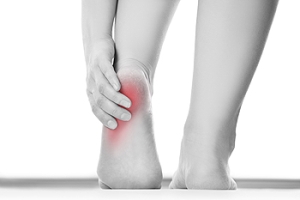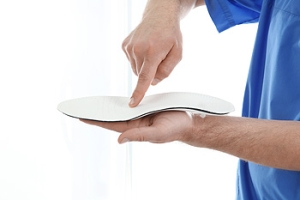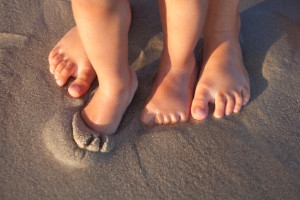
Choosing the Right Running Shoe
Choosing the right running shoes for you is an important part of running. A good pair of running shoes will make the running experience more enjoyable for you and prevent potential injury.
Poorly-fitted shoes can increase the risk of injury in runners substantially. Common injuries from running with poor quality shoes include shin splints, sprained ankles, Achilles tendinitis, stress fractures, plantar fasciitis and more. This is due to the fact that bad shoes do not provide proper foot support, can increase pronation (how much the foot rolls when hitting the ground), have little to no cushioning, do not allow the feet to breath, and do not provide enough flex and rigidity in the right parts.
When looking for running shoes, first, determine where you will be running. If you are a trail runner, then pick trail shoes. If you run on concrete and asphalt, then regular running shoes are the best choice. When trying on shoes, its best to go at the end of the day as feet grow during the day and shrink after a night of sleep. Shoes should be more rigid towards the back of the foot while being more flexible up where the toes are. The toe box should provide enough room for the toes to move freely. The overall fit should be snug, not too tight but not too loose. A good pair of running shoes should also provide enough arch support for your foot type. If you experience overpronation or under-pronation while running, try to find a pair of shoes that will help correct this with different sole patterns. Finally, try to find a pair of shoes that allow the feet to breathe like nylon mesh or synthetic leather.
Don’t forget about the socks either. Socks that hold too much moisture can lead to athlete’s foot. Socks should be breathable so that your feet can air out and breathe. Synthetic socks wick away moisture like sweat. If you tend to run a lot, having a second pair of shoes that you can wear while you let the first pair air out is smart. Just don’t forget to replace your shoes after about every 300 to 500 miles.
Before you start running, it is advised to see a podiatrist to see if running is right for you. They can also offer good advice on how to run and what to look for in a pair of running shoes. If you have flat feet or poorly supported ones, they can also offer custom-made orthotics that will help give your feet the support they need.
Types of Shoes That May Cause Cracked Heels
 The condition that is known as cracked heels may cause pain and discomfort if it is not treated promptly. It may occur more frequently during the summer months when open-back shoes are worn and may happen as a result of the inadequate support these types of shoes may offer. There are several methods to treat this unsightly foot condition, and these may include washing and thoroughly drying the feet daily, followed by utilizing a good moisturizer, which may aid in keeping the skin soft. Some patients find it helpful to wear cotton socks while sleeping, and this may be preceded by applying petroleum jelly to the affected area. Additionally, using a pumice stone or exfoliating foot cream may be successful in managing cracked heels. If you are afflicted with this ailment and would like additional information about how to prevent and treat cracked heels, it is suggested to speak with a podiatrist.
The condition that is known as cracked heels may cause pain and discomfort if it is not treated promptly. It may occur more frequently during the summer months when open-back shoes are worn and may happen as a result of the inadequate support these types of shoes may offer. There are several methods to treat this unsightly foot condition, and these may include washing and thoroughly drying the feet daily, followed by utilizing a good moisturizer, which may aid in keeping the skin soft. Some patients find it helpful to wear cotton socks while sleeping, and this may be preceded by applying petroleum jelly to the affected area. Additionally, using a pumice stone or exfoliating foot cream may be successful in managing cracked heels. If you are afflicted with this ailment and would like additional information about how to prevent and treat cracked heels, it is suggested to speak with a podiatrist.
If the skin on your feet starts to crack, you may want to see a podiatrist to find treatment. If you have any concerns, contact Dr. Michael A. Wood from Foot Health Institute. Our doctor can provide the care you need to keep you pain-free and on your feet.
Cracked Heels
It is important to moisturize your cracked heels in order to prevent pain, bleeding, and infection. The reason cracked heels form is because the skin on the foot is too dry to support the immense pressure placed on them. When the foot expands, the dry skin on the foot begins to split.
Ways to Help Heal Them
- Invest in a good foot cream
- Try Using Petroleum Jelly
- Ease up on Soaps
- Drink Plenty of Water
Ways to Prevent Cracked Heels
- Moisturize After Showering
- Skip a Shower
- Keep Shower Water Lukewarm
- Don’t Scrub Your Feet
If you are unsure how to proceed in treating cracked heels, seek guidance from a podiatrist. Your doctor will help you with any questions or information you may need.
If you have any questions, please feel free to contact one of our offices located in Lansing, and Chicago, IL . We offer the newest diagnostic and treatment technologies for all your foot care needs.
Solutions for Cracked Heels
Cracked heels may make you want to think twice about showing off your feet in warmer weather. However, cracked heels may be harmful to more than just the appearance of your feet. If deep fissures and cracks develop in your heels, they may make walking and standing painful for you. Additionally, these openings make way for germs to enter through your skin and cause infection.
There are several different causes of cracked heels. One of the most common reasons for this ailment is dry skin. This problem may make your keeps feel rough tight and itchy. Dry skin may be caused by cold air, extremely hot water, harsh soaps, and aging. Skin disorders such as eczema and psoriasis may eventually lead to dry skin. In some cases, complications may arise from cracked heels. Some of these complications are a loss of feeling in the heel, cellulitis, or a diabetic foot ulcer.
There are ways you can try to prevent getting cracked heels. One of the best ways to do so is to avoid wearing flip flops and sandals because these shoes increase your risk of drying out your feet. You should also avoid wearing shoes with a tall skinny heel, because these shoes cause your heel to expand sideways. At night, you should slather on a thick moisturizing cream on your feet and then cover them in socks to keep your feet moisturized overnight. Drinking water to stay hydrated is also a good way to ensure that your skin doesn’t become dry.
If you suffer from a severe case of cracked feet, you should make an appointment with your podiatrist to see what treatment methods are best for you.
Where Are Plantar Warts Located?
 The virus that causes most warts to develop is known as the human papillomavirus (HPV). This includes plantar warts, which grow into the heel of the foot as a result of constant pressure the foot endures from walking and standing. This type of virus generally enters the body through tiny cracks in the skin and is known to thrive in warm and moist places, which may include public pools, locker rooms, and surrounding areas. Plantar warts appear as a small and thickened area on the heel or sole of the foot and may have small blood vessels in the center, which appear as miniscule black dots. Small warts of this nature will generally produce minimal discomfort and will typically diminish on its own. If there are many warts, which may span a large portion of the sole of the foot, the pain and discomfort may be more severe. If you are afflicted with plantar warts, it is advised to consult with a podiatrist who can provide knowledge about correct treatment options.
The virus that causes most warts to develop is known as the human papillomavirus (HPV). This includes plantar warts, which grow into the heel of the foot as a result of constant pressure the foot endures from walking and standing. This type of virus generally enters the body through tiny cracks in the skin and is known to thrive in warm and moist places, which may include public pools, locker rooms, and surrounding areas. Plantar warts appear as a small and thickened area on the heel or sole of the foot and may have small blood vessels in the center, which appear as miniscule black dots. Small warts of this nature will generally produce minimal discomfort and will typically diminish on its own. If there are many warts, which may span a large portion of the sole of the foot, the pain and discomfort may be more severe. If you are afflicted with plantar warts, it is advised to consult with a podiatrist who can provide knowledge about correct treatment options.
Plantar warts can be very uncomfortable. If you need your feet checked, contact Dr. Michael A. Wood from Foot Health Institute. Our doctor will assist you with all of your foot and ankle needs.
About Plantar Warts
Plantar warts are the result of HPV, or human papillomavirus, getting into open wounds on the feet. They are mostly found on the heels or balls of the feet.
While plantar warts are generally harmless, those experiencing excessive pain or those suffering from diabetes or a compromised immune system require immediate medical care. Plantar warts are easily diagnosed, usually through scraping off a bit of rough skin or by getting a biopsy.
Symptoms
- Lesions on the bottom of your feet, usually rough and grainy
- Hard or thick callused spots
- Wart seeds, which are small clotted blood vessels that look like little black spots
- Pain, discomfort, or tenderness of your feet when walking or standing
Treatment
- Freezing
- Electric tool removal
- Laser Treatment
- Topical Creams (prescription only)
- Over-the-counter medications
To help prevent developing plantar warts, avoid walking barefoot over abrasive surfaces that can cause cuts or wounds for HPV to get into. Avoiding direct contact with other warts, as well as not picking or rubbing existing warts, can help prevent the further spread of plantar warts. However, if you think you have developed plantar warts, speak to your podiatrist. He or she can diagnose the warts on your feet and recommend the appropriate treatment options.
If you have any questions please feel free to contact one of our offices located in Lansing, and Chicago, IL . We offer the newest diagnostic and treatment technologies for all your foot and ankle needs.
All About Plantar Warts
Plantar warts are warts that are only found on the feet, hence the term “plantar”, which means “relating to the foot.” They are caused by the human papillomavirus, or HPV, and occur when this virus gets into open wounds on the feet. The warts themselves are hard bumps on the foot. They are easily recognizable, mostly found on the heels or ball of the foot. Plantar warts are non-malignant, but they can cause some pain, discomfort, and are often unsightly. Removing them is a common step toward treating them.
Plantar warts can cause some pain while standing, sometimes felt as tenderness on the sole of your foot. Unless the wart has grown into the foot behind a callus, you will be able to see the fleshy wart. A podiatrist should only be consulted if there is an excessive amount of pain. Plantar warts are not cancerous or dangerous, but they can affect your walking and continually reappear. Anyone who suffers from diabetes or a compromised immune system disease should seek out care immediately.
Podiatrists are easily able to diagnose plantar warts. They usually scrape off a tiny bit of the rough skin to make tiny blood clots visible and examine the inside of warts. However, a biopsy can be done if the doctor is not able to diagnose them from simply looking at them. Although plantar warts usually do not require an excessive amount of treatment, there are ways to go about removing them. A common method is to freeze them off using liquid nitrogen, removing them using an electrical tool, or burning them off via laser treatment. For a less invasive treatment option, topical creams can be used through a doctor’s prescription. This treatment method takes more time, however. Keep the wart covered for protection in between daily treatments.
The best way to avoid developing plantar warts is to avoid walking barefoot in public places. Avoid this especially if you have open sores or cuts on your feet. It is also important to avoid direct contact with warts in general, as they are highly contagious.
Does Wearing Orthotics Help to Relieve Foot Pain?
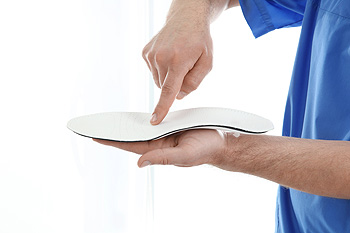 If you are experiencing foot pain as a result of disease or an arthritic condition, wearing custom-made orthotics may produce positive results. These are known as removable shoe inserts and may be helpful in providing moderate relief. The proper type and size of orthotics is determined by having an impression of the foot taken with a plaster cast mold, and this may allow for any necessary adjustments to be made. There are several foot conditions that may benefit from wearing orthotics, which may include plantar fasciitis, rheumatoid arthritis, or bunions. If you have uncomfortable pain in your feet, it is suggested to speak to a podiatrist who can discuss the benefits of wearing custom-made orthotics, and who is able to determine if this is right for you.
If you are experiencing foot pain as a result of disease or an arthritic condition, wearing custom-made orthotics may produce positive results. These are known as removable shoe inserts and may be helpful in providing moderate relief. The proper type and size of orthotics is determined by having an impression of the foot taken with a plaster cast mold, and this may allow for any necessary adjustments to be made. There are several foot conditions that may benefit from wearing orthotics, which may include plantar fasciitis, rheumatoid arthritis, or bunions. If you have uncomfortable pain in your feet, it is suggested to speak to a podiatrist who can discuss the benefits of wearing custom-made orthotics, and who is able to determine if this is right for you.
If you are having discomfort in your feet and would like to try orthotics, contact Dr. Michael A. Wood from Foot Health Institute. Our doctor can provide the care you need to keep you pain-free and on your feet.
What Are Orthotics?
Orthotics are inserts you can place into your shoes to help with a variety of foot problems such as flat feet or foot pain. Orthotics provide relief and comfort for minor foot and heel pain but can’t correct serious biomechanical problems in your feet.
Over-the-Counter Inserts
Orthotics come in a wide variety of over-the-counter inserts that are used to treat foot pain, heel pain, and minor problems. For example, arch supports can be inserted into your shoes to help correct overarched or flat feet, while gel insoles are often used because they provide comfort and relief from foot and heel pain by alleviating pressure.
Prescription Orthotics
If over-the-counter inserts don’t work for you or if you have a more severe foot concern, it is possible to have your podiatrist prescribe custom orthotics. These high-quality inserts are designed to treat problems such as abnormal motion, plantar fasciitis, and severe forms of heel pain. They can even be used to help patients suffering from diabetes by treating foot ulcers and painful calluses and are usually molded to your feet individually, which allows them to provide full support and comfort.
If you are experiencing minor to severe foot or heel pain, it’s recommended to speak with your podiatrist about the possibilities of using orthotics. A podiatrist can determine which type of orthotic is right for you and allow you to take the first steps towards being pain-free.
If you have any questions please contact one of our offices located in Lansing, and Chicago, IL . We offer the newest diagnostic and treatment technologies for all your foot and ankle needs.
Ankle Foot Orthotics for Athletes
Ankle foot orthotics are shoe inserts that offer support to control the placement and movement of the ankle, correct deformities, and compensate for weakness. These inserts are used to stabilize the foot and ankle and provide toe clearance during the swing phase of gate.
Athletes often suffer foot problems because their feet are not being supported within the shoe. Ankle and foot orthotics are custom made inserts that alleviate stress on the foot. However custom orthotics should be prescribed by a podiatrist who specializes in customized footwear and orthotics design. These inserts are used by athletes for different reasons. Runners use orthotics to absorb shock at heel contact and to set up the forefoot for push-off. Basketball players wear them to control their forefeet while jumping and running.
The two main types of orthotics are over-the-counter orthotics and custom-made orthotics. To be eligible for custom orthotics, an examination of the foot and ankle will need to be completed. Afterward, both the foot and ankle will need to be casted and fitted for the proper orthotic. When the fitting process is complete, adjustments can be made to make sure everything fits perfectly.
Over the counter orthotics tend to be more popular than custom fit ones. Athletes who have less severe aches and pains in the foot, ankle or lower back area can use the over-the-counter version of orthotics. Unfortunately, over-the-counter orthotics tend to not work in treating severe injuries or ailments. Whenever you suspect you may need an ankle foot orthotic, you should consult with your podiatrist to determine which type of orthotic is right for you.
Walking Barefoot May Be Beneficial to Your Child’s Feet
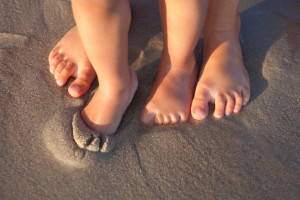 When babies are born, the tendons, joints, and bones are flexible, and this will typically result in children having flat feet until they are older. It may be beneficial to periodically have your child’s feet checked, which may ensure they are developing correctly. Research has shown the foot is comprised of 26 bones and that walking barefoot may aid in the proper development of strong bones and muscles. Wearing socks are beneficial in keeping the feet warm, and a good fit occurs when the socks are one quarter of an inch longer than the biggest toe. The importance of choosing the right size shoe is crucial in possibly preventing uncomfortable foot conditions from developing. It may be helpful to know that a sturdy shoe may be the best choice for this early stage of foot development, in addition to choosing leather soles, which may aid in traction. If you would like additional information about other forms of maintaining good foot health for your child, it is advised to speak with a podiatrist.
When babies are born, the tendons, joints, and bones are flexible, and this will typically result in children having flat feet until they are older. It may be beneficial to periodically have your child’s feet checked, which may ensure they are developing correctly. Research has shown the foot is comprised of 26 bones and that walking barefoot may aid in the proper development of strong bones and muscles. Wearing socks are beneficial in keeping the feet warm, and a good fit occurs when the socks are one quarter of an inch longer than the biggest toe. The importance of choosing the right size shoe is crucial in possibly preventing uncomfortable foot conditions from developing. It may be helpful to know that a sturdy shoe may be the best choice for this early stage of foot development, in addition to choosing leather soles, which may aid in traction. If you would like additional information about other forms of maintaining good foot health for your child, it is advised to speak with a podiatrist.
The health of a child’s feet is vital to their overall well-being. If you have any questions regarding foot health, contact Dr. Michael A. Wood of Foot Health Institute. Our doctor can provide the care you need to keep you pain-free and on your feet.
Tips for Keeping Children's Feet Healthy
- Make sure their shoes fit properly
- Look for any signs of in-toeing or out-toeing
- Check to see if they have Clubfoot (condition that affects your child’s foot and ankle, twisting the heel and toes inward) which is one of the most common nonmajor birth defects.
- Lightly cover your baby’s feet (Tight covers may keep your baby from moving their feet freely, and could prevent normal development)
- Allow your toddler to go shoeless (Shoes can be restricting for a young child’s foot)
- Cut toenails straight across to avoid ingrown toenails
- Keep your child’s foot clean and dry
- Cover cuts and scrapes. Wash any scratches with soap and water and cover them with a bandage until they’ve healed.
If you have any questions, please feel free to contact one of our offices located in Lansing, and Chicago, IL . We offer the newest diagnostic and treatment technologies for all your foot care needs.
How to Care for Your Child's Feet
It is never normal for a child to experience pain in his or her feet. Foot pain that lasts more than a few days and limits a child’s ability to walk should be examined by a podiatrist. Many adult foot ailments originate in childhood and may be present at birth. Common foot issues that are experienced by children are pediatric flat foot, Sever’s disease, ingrown toenails, and plantar warts.
A child’s foot grows rapidly during the first year, allowing it to reach almost half of their adult foot size. Consequently, foot specialists consider the first year to be the most crucial point in the foot development process. There are ways you can help ensure that your child’s foot develops properly. One way is to carefully look at your baby’s feet. If you notice any deformities, you should immediately seek professional care. You should also loosely cover your child’s foot, since tight coverings may prevent movement and inhibit normal development. Another tip is to change the baby’s positioning throughout the day. If your baby lies down in one spot for too long, it may put an excess amount of strain on the feet and legs.
It is best that you try not to force a child to start walking. Children will begin to walk when they are both physically and emotionally capable to do so. You should also avoid comparing your child’s walking progress with other children because the age range for independent walking may range. When your child’s feet begin to develop, you may need to change both their shoe and sock size every few months to allow room for their feet to grow.
Kids are sometimes prone to splinters, cuts, and severe injuries because they tend to walk around barefoot. This also makes them more susceptible to developing plantar warts which is a condition caused by a virus that invades the sole of the foot through breaks in the skin. These ailments can be avoided by making sure your child wears shoes in unsanitary environments. You should also wash any minor cuts or scrapes on your child’s feet. It is a myth that exposure to fresh air will heal injuries; fresh air will only expose your child’s cuts to germs.
As a parent, you should ensure that your child’s feet are developing properly and are being properly maintained. Consequently, it is important that you perform routine inspections on his or her feet to detect any injuries or deformities in their early stages. Early detection and treatment will help to ensure that your child does not develop any serious foot conditions.



